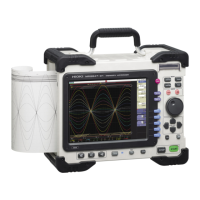8.10 Making Detailed Settings for Input Modules
142
See: Opening the [Each Ch] sheet, Making a Channel Selection ( p.140)
Mode Set to match the type of thermocouple being used.
RJC (Reference
Junction Compen-
sation)
When connecting a thermocouple directly to the input module, select [Int].
Reference junction compensation is performed within the input module. When
connecting through a reference junction device (e.g., a 0°C control tank), select
[Ext].
Burn Out A broken thermocouple wire can be detected during temperature measurement.
Normally when a thermocouple wire breaks, measured values exhibit random
instability.
8.10.3 Settings for the 8967 Temp Unit
Selections Measurement Range Selections Measurement Range
Temp- K
-200 to 1350°C
Temp- R
0 to 1700°C
Temp- J
-200 to 1100°C
Temp- S
0 to 1700°C
Temp- E
-200 to 800°C
Temp- B
400 to 1800°C
Temp- T
-200 to 400°C
Temp- W
0 to 2000°C
Temp- N
-200 to 1300°C
Selections Description
INT
Reference junction compensation is provided within the input mod-
ule. (default setting)
(Measurement Accuracy: The sum of the accuracies of the temper-
ature measurement and the reference junction compensation.)
EXT Reference junction compensation is not provided within the input
module.
(Measurement Accuracy: The accuracy of temperature measure-
ment only)
Selections Description
Off
Broken wires are not detected.
On Broken wires are detected.
Wire breakage is detected by sensing a miniscule current flow
(about 100 nA) through the thermocouple. If the thermocouple
wires are long or composed of a high-resistance material, set [Burn
Out] to [Off] to avoid measurement errors.

